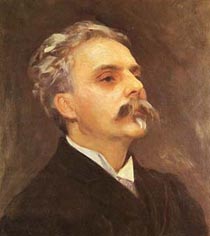

GABRIEL FAURE (URBIAN)
12thMay 1845 --- 4thNovember 1924
Copyright 1994-1998 Encyclopaedia Britannica
Last Updated on September 2025
By Steven Ritchie
And now for the Music

NEW (4784)"Clair Delune, Opus46.no.2. Sequencer by Unknown.
Thanks to Taki for the music below.
(3487)"Requiem, No.1, Opus.48". Sequenced by Taki. (3486)"Requiem, No.6, Opus.48". Sequenced by Taki. (3485)"Requiem, No.7, Opus.48". Sequenced by Taki. Thanks to Joao Rocha for the music below, Email (joao.rocha@loggo.com.br)
(2708)"Berceuse Op.16 for flute and piano". Sequenced by Joao Rocha. Thanks to Emily Gray for the music below, Email (HappyMusician@opendiary.com)
(2409)"Romance sans paroles". Sequenced by Emily Gray. (1767)"Cantique de Jean Racine". Sequenced by Emily Gray Thank s to George Pollen for the music below. Link to his wedsite on my Bookmark page.
(2194)"Sicilienne, from the Suite Pelleas & Melisande". Sequenced by George Pollen. (842)"Berceuse". Sequenced by George Pollen (687)"Dolly Suite extract". Sequenced by George Pollen (689)"Overture Masque & Bergamasque". Sequenced by George Pollen Thanks to Atyim for the music below. Email (atyim@hal.ne.jp)
(1353)"Fleur jetee". Sequenced by Atyim (1354)"Les roses d' Ispahan". Sequenced by Atyim (1356)"Nocturne". Sequenced by Atyim (1357)"Spleen Song". Sequenced by Atyim (1358)"Noctune". Sequenced by Atyim (757)"Souvenirs de Bayreuth". Sequenced by David Siu (1a)"Le Jardin de Dolly No.3". Sequenced by Katsuhiro Oguri (2a)"Requiem Agnus Dei". Sequenced by Dominique Rayett (356)"Le Jardin de Dolly No.2". Sequencer unknown

If you done any Classical pieces of say for example, Delius, mozart, and so on etc,
please email them to the classical music site with details to
"classical (@) ntlworld.com" written this way to stop spammers
just remove spaces and brackets for email address, thank you.

Visitors to this page --

Back to Classical Midi Main Menu click "HERE"